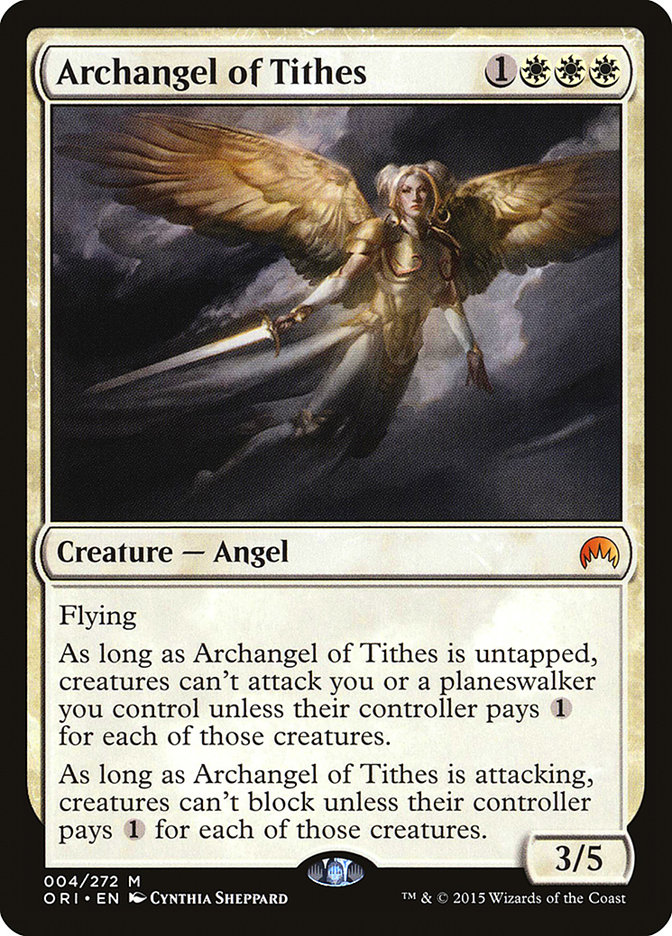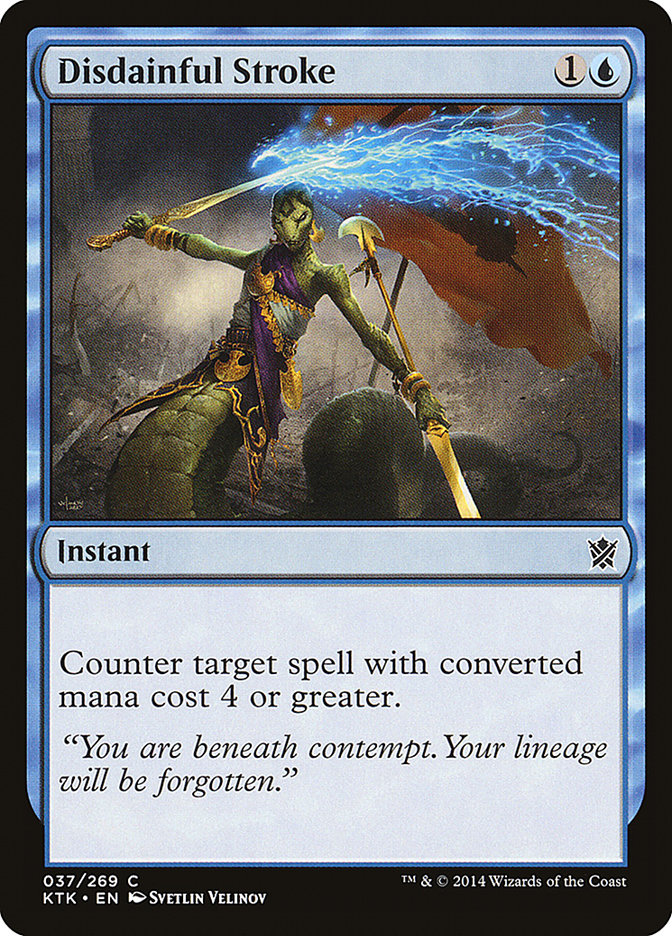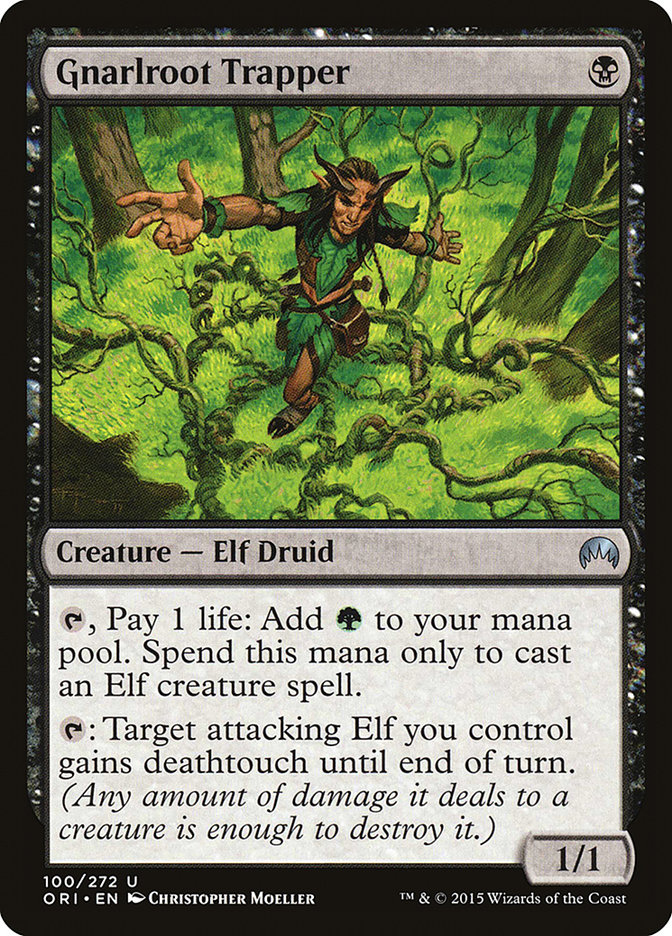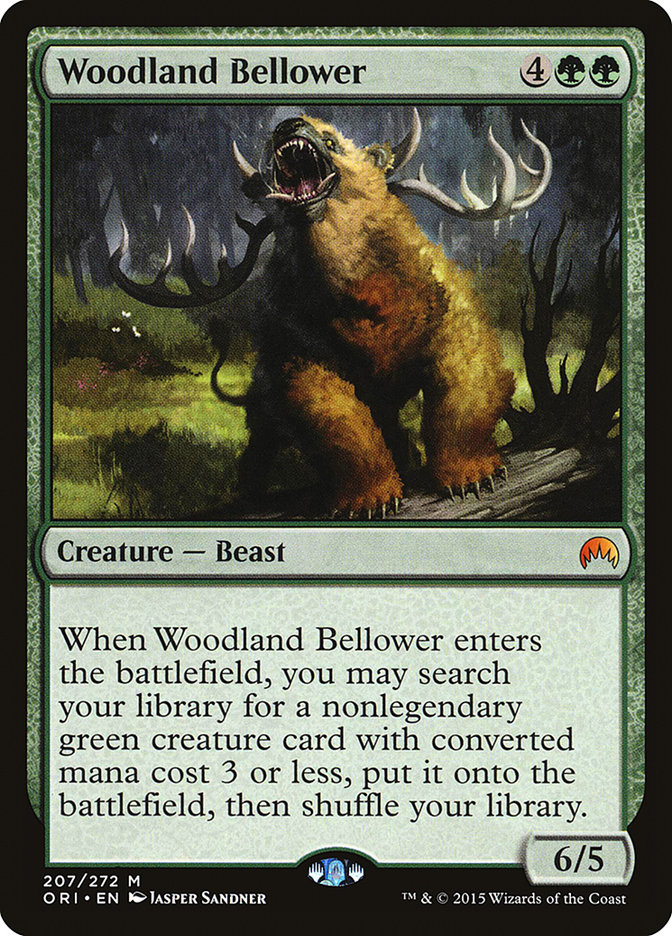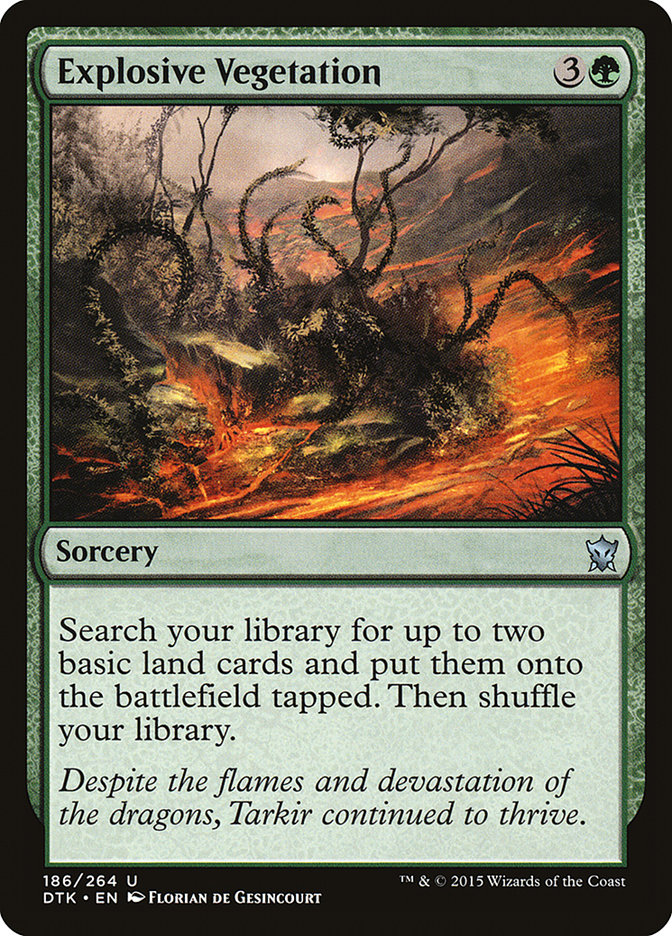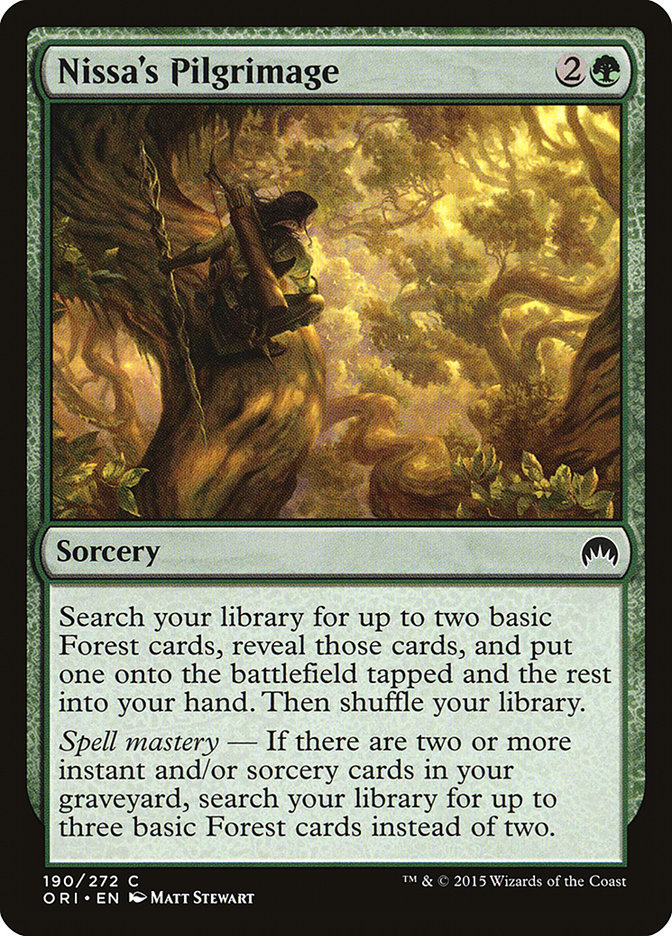Magic Origins is a strange thing. It’s the last Core Set, but in a way it feels like the first time a Core Set has truly had the creative direction to stand on its own. That’s not to say that previous Core Sets were failures creatively, because on an individual-card level the Core Sets since M10 have been great from a flavor standpoint. However, they’ve always felt like a mashup of different elements without a central theme. Here, with the last Core Set, it seems we’ve finally found a theme – Origins.
With the last Core Set also comes the final time we’ll see a Standard format this big. Right now, Standard has eight different sets – M15, Origins, Theros Block, and Khans of Tarkir Block. Once the new rotation policy comes along, that won’t happen again. Standard will instead shift between five and six sets as we move toward two-set blocks that rotate in and out more frequently. While I’m excited for that future and its more frequent seismic shifts in Standard that upend the metagame, we still have one eight-set Standard metagame to figure out.
With the full Magic Origins spoiler available and the prerelease nearly here, we have all the tools we need to start building decks for the new format. While I have yet to start really practicing for the Pro Tour just yet, I have certainly begun brewing decks in my head. Let’s take a look at some of them, shall we?
Creatures (25)
- 4 Knight of the White Orchid
- 4 Soldier of the Pantheon
- 3 Brimaz, King of Oreskos
- 4 Mardu Woe-Reaper
- 3 Anafenza, Kin-Tree Spirit
- 3 Kytheon, Hero of Akros
- 4 Archangel of Tithes
Lands (23)
- 23 Plains
Spells (12)

This is a very rough list, but it includes several of the most exciting new cards in Magic Origins. While I think much of the hype around Kytheon may be somewhat overblown, if he has a home I expect it’s in a list like this – one that is built to be consistent and low to the ground. Knight of the White Orchid is a card with a Pro Tour-winning pedigree, as it was a powerful tool in Paul Rietzl PT Amsterdam winning Extended deck back in 2010. And Archangel of Tithes is clearly an extremely powerful card to just about anyone who can read: it’s a 3/5 flier for four mana with two quite-potent abilities.
Eleven one-drops along with Raise the Alarm helps maximize the potential to flip a Kytheon on turn three. I’m not altogether sold on Mardu Woe-Reaper, but it seemed like the best of the rest of the attacking one-drops after Kytheon and Soldier of the Pantheon. It’s possible that Aven Skirmisher might be a better option if you’re looking for creatures that can attack into more boards without fear, thanks to Flying, but only having one point of power makes it a hard sell. Herald of Anafenza is another option, which is a weaker attacker immediately but a more powerful creature over time that offers a possible mana sink.
I could also imagine playing a mix of spells more heavily slanted toward Celestial Flares rather than Valorous Stances. Celestial Flare is a reprint coming back in Magic Origins that does a few important things. First, and probably most importantly, it gives white decks an answer to Stormbreath Dragon, which was previously pretty much just game over. Secondly, it also serves as a general-purpose removal effect that lets a deck like this just attack into a blocker like Fleecemane Lion or Courser of Kruphix early in the game that might otherwise stonewall the deck’s smaller creatures.
Archangel of Tithes is another card that helps on both of those accounts. If you play an Archangel of Tithes and your opponent taps out to play a Stormbreath Dragon, they can’t attack with it nor can they block with it when you attack on the following turn. Archangel is really a nightmare for anyone looking to participate in creature combat in the early and middle turns of the game, especially since the effect stacks and the additional cost your opponent has to pay is cumulative for each Archangel you control. While your opponent may often have bigger creatures than you, they’ll have to carefully manage their resources if they want to continue developing their board and actually use those creatures at the same time.
Archangel also happens to work very well against Elspeth, Sun’s Champion. For starters, she is a three-power flying creature, which means she is personally out of range of Elspeth’s minus ability and can fly over the tokens the planeswalker creates. On top of that, her tax on blocking makes it much easier to attack through said solider tokens. If you have an Archangel and pretty much anything else on the table and your opponent taps out for Elspeth, she’s almost certainly going to die.
That said, this deck likely doesn’t have what it takes to compete with many of the top Standard decks right now. A world full of Courser of Kruphixs and Sylvan Caryatids is not a friendly one for a Savannah Lion, even one with a bunch of extra abilities. Attacking with small creatures on the ground doesn’t line up very well against Deathmist Raptor either, and those same small ground creatures are easily burned to a crisp by a Devotion deck ramping into Dragonlord Atarka. Both Anafenza and Spear of Heliod help bolster your army to some degree – in the former case, quite literally – but that seems unlikely to be enough to deal with all of the roadblocks an aggressive white creature deck faces.
There are certainly ways to address some of these concerns with additional colors, but none of the new cards I’m excited about here – Kytheon, Knight of the White Orchid, or Archangel – play particularly well outside of an extremely white-heavy deck. Kytheon in particular really wants to come down on turn one and wants his support to come down soon thereafter, so a deck that wants to use him really isn’t interested in lands that enter the battlefield tapped.
Here’s another take at a list using the other two, however:
Creatures (27)
- 4 Knight of the White Orchid
- 1 Heliod, God of the Sun
- 1 Ephara, God of the Polis
- 3 Brimaz, King of Oreskos
- 4 Stratus Dancer
- 3 Hidden Dragonslayer
- 4 Dragonlord Ojutai
- 2 Icefall Regent
- 1 Kytheon's Irregulars
- 4 Archangel of Tithes
Lands (24)
Spells (9)

This deck is clearly far less streamlined than the last one, with a lot of single copies of cards, but that’s because I’m trying to illustrate an idea more than I’m trying to put together an actual deck. The idea here is a midrange W/U creature deck that attempts to maximize the power of Knight of the White Orchid.
Knight is a great way to catch up on tempo when you’re not fortunate enough to win the die roll in a matchup, but it can do more than just ramp you in mana. One thing about Knight of the White Orchid that is important to note is that the Plains you fetch with it enters the battlefield untapped, which means you can tap it for mana that same turn. The most common case for this is likely to be playing a Knight of the White Orchid on turn three before playing your land, fetching a Plains and then playing another land, leaving you with two mana untapped. You can then use that mana to play another two-mana spell like Disdainful Stroke.
Being able to develop your board, ramp your mana, and hold up mana for Disdainful Stroke going into your opponent’s fourth turn is a very exciting prospect to me. Normally, Disdainful Stroke is a card that is usually strong when you’re on the play but quite poor when you’re on the draw because you have to choose between playing something meaningful or holding up mana to potentially counter your opponent’s spell. In this case, you get to do both. Granted, in order to have access to blue mana in this instance you have to draw one of your Islands or Flooded Strands since they’re the only untapped sources of blue mana in the deck, but that’s the price of playing heavily color-intensive cards like Knight and Archangel.
Speaking of Archangel, in this deck she serves much the same role as in the last, but also happens to lend her color-intensive casting cost to the devotion of Heliod and Ephara. I’m not sure if the Gods are worth it here, but both Knight and Archangel have quite a few colored symbols to help activate them. Any white creature along with Archangel is enough to turn Heliod on, while even in his dormant state Heliod helps Archangel do double duty with her abilities. An Archangel with Vigilance can help prevent your opponent’s creatures from being able to attack or block at the same time, which can make it very difficult for them to make any real headway.
Dragonlord Ojutai may not offer much Devotion for Heliod, but he also works quite well with Vigilance, never having to become vulnerable to spot removal since he doesn’t tap to attack and thus never loses hexproof. It’s possible that this deck might actually want more copies of Heliod thanks to these synergies along with the white mana symbols on Knight of the White Orchid and others, but I’d rather experiment with a variety of different cards before I go in that direction.
Speaking of experiments, there are quite a few cards in here that are present for exactly that reason, like the Gods. Kytheon’s Irregulars is another. A 4/3 body for four mana isn’t exciting by itself, but a repeated-use tap effect seems like it has quite a bit of potential to break stalemates. Similarly, Ojutai’s Command is a card that seems like it gains quite a bit of value from Knight of the White Orchid since it’s a quality two-drop to return on a lot of board states that can offer us an additional advantage. I actually had a sketch that was heavier on Dragons, with four copies each of Ojutai and Icefall Regent, and it included Orators of Ojutai as another early creature that’s great to potentially return with Command. It’s worth thinking about at least.
Where this deck seems like it might struggle is quite the opposite of the last one. With only Knight of the White Orchid and Brimaz as solid early creatures, I can see this deck struggling significantly with faster opposing creature decks – which is precisely why I was considering the Orator of Ojutai configuration. I feel like this deck really wants more creatures like Knight and Brimaz that can serve as solid proactive or defensive plays to help set up the powerful fliers in the mid- and late-game. Perhaps the Megamorph pair of Stratus Dancer and Hidden Dragonslayer aren’t worth the slots, or maybe they ought to start out in the sideboard.
By now I’m sure you’re all thinking – who the heck is this guy and what did he do with Brian Kibler? White decks are one things, but W/U decks? Where are the forests? Don’t worry – I’ve saved the best for last!
Creatures (35)
- 4 Sylvan Messenger
- 4 Elvish Visionary
- 4 Elvish Mystic
- 3 Nissa, Vastwood Seer
- 3 Gilt-Leaf Winnower
- 3 Dwynen, Gilt-Leaf Daen
- 2 Woodland Bellower
- 4 Dwynen's Elite
- 4 Gnarlroot Trapper
- 4 Shaman of the Pack
Lands (24)
Spells (1)

This is another rough linear sketch that is frankly probably a bit too all-in to be reasonable. The idea here is to leverage the Tribal Elf effects along with the eight one-drop Elf mana accelerants as effectively as possible. One of the biggest problems with most decks that are heavy on mana creatures is that they can’t effectively leverage those mana creatures in the late game, which is why cards like Gavony Township are so important. We don’t have Gavony Township here, but we do have Shaman of the Pack, which threatens to close out games with a Fireball-like finisher if you’re able to keep your board full of Elves.
Thankfully, there are a lot of tools available to do just that. Dwynen’s Elite, Elvish Visionary, Nissa, and Sylvan Messenger all offer their own bodies plus some. Visionary and Messenger in particular help you dig through your deck to find the specific Elves you need to help close out the game, whether it’s Shaman of the Pack to actually end it or Gilt-Leaf Winnower to clear a Siege Rhino or something similar out of the way to keep pressing your offense.
Gnarlroot Trapper is a big part of that offense as well. Not only does it help ramp you into your mid-and high-cost Elves, it can also let your smaller creatures attack into larger ones with impunity. While Trapper’s mana production is only effective to cast Elves, it can remain useful later into the game thanks to its ability to give Deathtouch to your attackers. That’s a big deal: it can let your swarms of small Elves or Elf tokens from Dwynen’s Elite attack into boards full of Siege Rhinos and whatever else to help whittle your opponent down.
The one creature in the entire deck that Gnarlroot Trapper can’t help cast is Woodland Bellower. Now it’s possible that this may just not belong since the non-legendary clause means that it can’t fetch Nissa, but the idea of having extra ways to search up copies of Shaman of the Pack is really appealing to me. Chord of Calling may just be better, since it has more versatility – it can find Shaman, Nissa, Dwynen, or Winnower – but it doesn’t have as much raw power as the Bellower does with its 6/5 body attached. That said, if you’re just looking to chain direct damage effects and don’t care about “value,” Chord is probably the direction to go.
This deck feels like it may have a solid game one in a lot of matchups, but I suspect it will struggle against opponents with mass removal effects like Drown in Sorrow – it is just a pile of creatures, after all. You can obviously sideboard cards like Thoughtseize against sweepers, but it doesn’t seem like this deck would win fast enough to beat most decks before they could draw into a sweeper since it relies on critical mass of Elves at all points in the game. Granted, you can sandbag somewhat thanks to Messenger and you can potentially get many of your creatures out of Drown range with Dwynen, but I suspect it might be tough regardless.
If you’re looking for a deck with Nissa that is a bit better against Drown in Sorrow…
Creatures (23)
- 4 Elvish Mystic
- 4 Sylvan Caryatid
- 4 Courser of Kruphix
- 4 Dragonlord Atarka
- 3 Dragonlord Dromoka
- 4 Nissa, Vastwood Seer
Planeswalkers (4)
Lands (25)
Spells (8)

I actually built a deck very similar to this during playtesting for Pro Tour Dragons of Tarkir because I was excited about the possibility of using Explosive Vegetation to ramp into big Dragons. Well, now we have not only Explosive Vegetation but also Nissa’s Pilgrimage that allow us to generate removal-proof mana sources we can use to play our gigantic Dragons.
Nissa herself fits into this kind of deck absolutely perfectly. In the early game, she gives you a body that can block along with an extra land to ensure you don’t miss a drop. Later on – and not necessarily that much later, thanks to the eight two-land ramp effects – she can flip into her planeswalker form, which offers card draw, threat generation and more.
One tiny tip to keep in mind when playing Nissa, by the way. Her flip ability goes on the stack when you play a land, so your opponent has the opportunity to respond to the trigger with a creature removal spell. If you happen to keep a fetchland handy, however, you can respond to your opponent’s removal spell to trigger her transformation again, effectively saving her from the removal effect.
I think there are a lot of ways to build a Nissa Pilgrimage ramp deck – this is just the first one that came to mind, because of my prior experience with a similar build during my Pro Tour testing. While Pilgrimage itself can only get basic Forests, there are lots of mana-fixing tools available, so you can play anything from Naya, like this list, to mono-green or Jund or Bant or whatever else. I’m somewhat drawn to trying a G/B or perhaps Sultai list with Nissa that ramps into the biggest of Garruks – that’s a pretty powerful planeswalker to cast early in the game.
While significantly slower than the mana creature-based ramp of the more common G/R Devotion decks, the Nissa/land ramp package offers more stability against removal as well as the promise of an extremely powerful late-game from not just the expensive cards you’re ramping into but also from Nissa herself. Getting paid off late by a card that’s also quite strong early on is awesome, and Nissa does just that. She’s got my early vote for breakout card of the set.
What do you think? What new cards are you looking to build around? Who do you think is the real star of Magic Origins?


